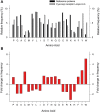Principles of agonist recognition in Cys-loop receptors
- PMID: 24795655
- PMCID: PMC4006026
- DOI: 10.3389/fphys.2014.00160
Principles of agonist recognition in Cys-loop receptors
Abstract
Cys-loop receptors are ligand-gated ion channels that are activated by a structurally diverse array of neurotransmitters, including acetylcholine, serotonin, glycine, and GABA. After the term "chemoreceptor" emerged over 100 years ago, there was some wait until affinity labeling, molecular cloning, functional studies, and X-ray crystallography experiments identified the extracellular interface of adjacent subunits as the principal site of agonist binding. The question of how subtle differences at and around agonist-binding sites of different Cys-loop receptors can accommodate transmitters as chemically diverse as glycine and serotonin has been subject to intense research over the last three decades. This review outlines the functional diversity and current structural understanding of agonist-binding sites, including those of invertebrate Cys-loop receptors. Together, this provides a framework to understand the atomic determinants involved in how these valuable therapeutic targets recognize and bind their ligands.
Keywords: Cys-loop receptors; GABA-A receptors; GluCl; glycine receptors; ion channels; ligand recognition; nicotinic acetylcholine receptors; serotonin receptors.
Figures






Similar articles
-
Structural insights into Cys-loop receptor function and ligand recognition.Biochem Pharmacol. 2013 Oct 15;86(8):1042-53. doi: 10.1016/j.bcp.2013.07.001. Epub 2013 Jul 10. Biochem Pharmacol. 2013. PMID: 23850718 Review.
-
The Haemonchus contortus LGC-39 subunit is a novel subtype of an acetylcholine-gated chloride channel.Int J Parasitol Drugs Drug Resist. 2023 Aug;22:20-26. doi: 10.1016/j.ijpddr.2023.04.001. Epub 2023 Apr 6. Int J Parasitol Drugs Drug Resist. 2023. PMID: 37054482 Free PMC article.
-
The Cys-loop superfamily of ligand-gated ion channels: the impact of receptor structure on function.Biochem Soc Trans. 2004 Jun;32(Pt3):529-34. doi: 10.1042/BST0320529. Biochem Soc Trans. 2004. PMID: 15157178 Review.
-
The minimum M3-M4 loop length of neurotransmitter-activated pentameric receptors is critical for the structural integrity of cytoplasmic portals.J Biol Chem. 2013 Jul 26;288(30):21558-68. doi: 10.1074/jbc.M113.481689. Epub 2013 Jun 5. J Biol Chem. 2013. PMID: 23740249 Free PMC article.
-
Discovery of a novel allosteric modulator of 5-HT3 receptors: inhibition and potentiation of Cys-loop receptor signaling through a conserved transmembrane intersubunit site.J Biol Chem. 2012 Jul 20;287(30):25241-54. doi: 10.1074/jbc.M112.360370. Epub 2012 May 15. J Biol Chem. 2012. PMID: 22589534 Free PMC article.
Cited by
-
Dynamic closed states of a ligand-gated ion channel captured by cryo-EM and simulations.Life Sci Alliance. 2021 Jul 1;4(8):e202101011. doi: 10.26508/lsa.202101011. Print 2021 Aug. Life Sci Alliance. 2021. PMID: 34210687 Free PMC article.
-
Discovering cryptic pocket opening and binding of a stimulant derivative in a vestibular site of the 5-HT3A receptor.Sci Adv. 2025 Apr 11;11(15):eadr0797. doi: 10.1126/sciadv.adr0797. Epub 2025 Apr 11. Sci Adv. 2025. PMID: 40215320 Free PMC article.
-
Highlighting membrane protein structure and function: A celebration of the Protein Data Bank.J Biol Chem. 2021 Jan-Jun;296:100557. doi: 10.1016/j.jbc.2021.100557. Epub 2021 Mar 18. J Biol Chem. 2021. PMID: 33744283 Free PMC article. Review.
-
Cryo-EM structure of the benzodiazepine-sensitive α1β1γ2S tri-heteromeric GABAA receptor in complex with GABA.Elife. 2018 Jul 25;7:e39383. doi: 10.7554/eLife.39383. Elife. 2018. PMID: 30044221 Free PMC article.
-
EPR Studies of Gating Mechanisms in Ion Channels.Methods Enzymol. 2015;557:279-306. doi: 10.1016/bs.mie.2014.12.030. Epub 2015 Mar 24. Methods Enzymol. 2015. PMID: 25950970 Free PMC article. Review.
References
-
- Amin J., Weiss D. S. (1994). Homomeric rho 1 GABA channels: activation properties and domains. Receptors Channels 2, 227–236 - PubMed
Publication types
LinkOut - more resources
Full Text Sources
Other Literature Sources

